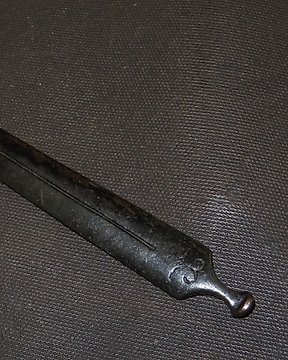
Katana - Suaka - Hijyogi Kogai : C3-930 - Giappone - Periodo Edo (1600-1868)
N. 38917691

N. 38917691

****Very beautiful piece****
Antique Katana from the Edo era (circa the Kan'ei era, 1624). The sword is signed by 'Kane', which the NBTHK (Japanese Sword Museum) has attributed to the famous blacksmith Kanenori from the Edo era, who lived in Kaga no kuni, in the modern-day prefecture of Ishikawa. This sabre comes with an original trial certificate (Hozon level) of the NBTHK (Nihon bijutsu token hozon kyokai) dating from 2018, Society of Preservation and Registry of Japanese Sabres, guaranteeing its authenticity, origin and signature. Very good condition overall, the blade (o-suriage) has antique polishing, there are some scratches and wear (please look at the photos). The sabre is well preserved in its protection sheath (Shirasaya), the gold-plated, copper Habaki is in very good condition. The blade shape is Shinogi zukuri. Please appreciate the beauty of this blade with its Hamon Gonome-midare, imposing and magnificent. It is a quality blade, made by a prestigious smith.
From the last Muromachi period, the province of Mino experienced a regular outflow of blacksmiths, a trend that peaked in the Momoyama period and the early Edo period. The reason was largely the high demand for swords at the time, so the local Daimyos began recruiting famous masters to work for them on their lands. The Mino blades, or Seki blades in particular, were considered to be durable and sharp, so a wave of blacksmiths migrating from Mino/Seki is observed, particularly in the neighbouring provinces of Owari and Echizen As for Echizen, the province also gave many Shimosaka blacksmiths a new home, based in Omi, so we use classifications such as 'Echizen-Seki' and 'Echisen-Shimosaka' to differentiate between the two. The pioneers of the Echizen-Seki were first and foremost from the Tenbun era.
The 2nd generation Kanenori blacksmith belonged to the Kanenori lineage whose ancestor was a blacksmith of the same name who had moved some time during the Tenbun era from Mino to Echigo province. The blade of the blacksmith in question is his son to whom he attributed all his knowledge, this one has kept the same name Kanenori. He moved to Echizen, and is now considered the second generation of this lineage. He then joined the local Echizen-Shimosaka school (probably by marriage), was allowed to use the family name Shimosaka and is thus known under the real name Shimosaka Ichizaemon. He was active around Kanbun (1661-1673) and was successively granted with the honorary titles of Chikugo no Daijô and Chikugo no Kami. His years of birth and death are unknown, but we recognise blades from Kan’ei (1624- 1644) to Enpô (1673-1681). These blades are called Wazamono, because they are known to be very sharp.
Dimensions / weight:
Hacho (Length of the blade): 69.7 cm
Sori (curve): 1.0 cm
Motomihaba: 3.11 cm
Motokasane: 7.1 mm
Sakimihaba: 2.41 cm
Sakikasane: 5.6 mm
Nakago (length of the sleeve): 19.3 cm
Weight of the blade alone (approx.) : 718 g
Total weight of the blade with the Shirasaya (approx.) : 1,029 g
Total length with the Shirasaya: 92.8 cm
- A very sharp blade -
Delivery:
Careful shipping, insurance included.
The sale, purchase and possession of weapons is subject to national laws and regulations. Please make sure that you know the laws and regulations of your country BEFORE bidding. The sale of weapons to people under the age of 18 is prohibited. By placing an offer, you declare that you are at least 18 years of age or older and that you have verified that you are authorised to legally purchase such articles in your country.
Come fare acquisti su Catawiki
1. Scopri oggetti speciali
2. Fai l’offerta più alta
3. Paga in tutta sicurezza